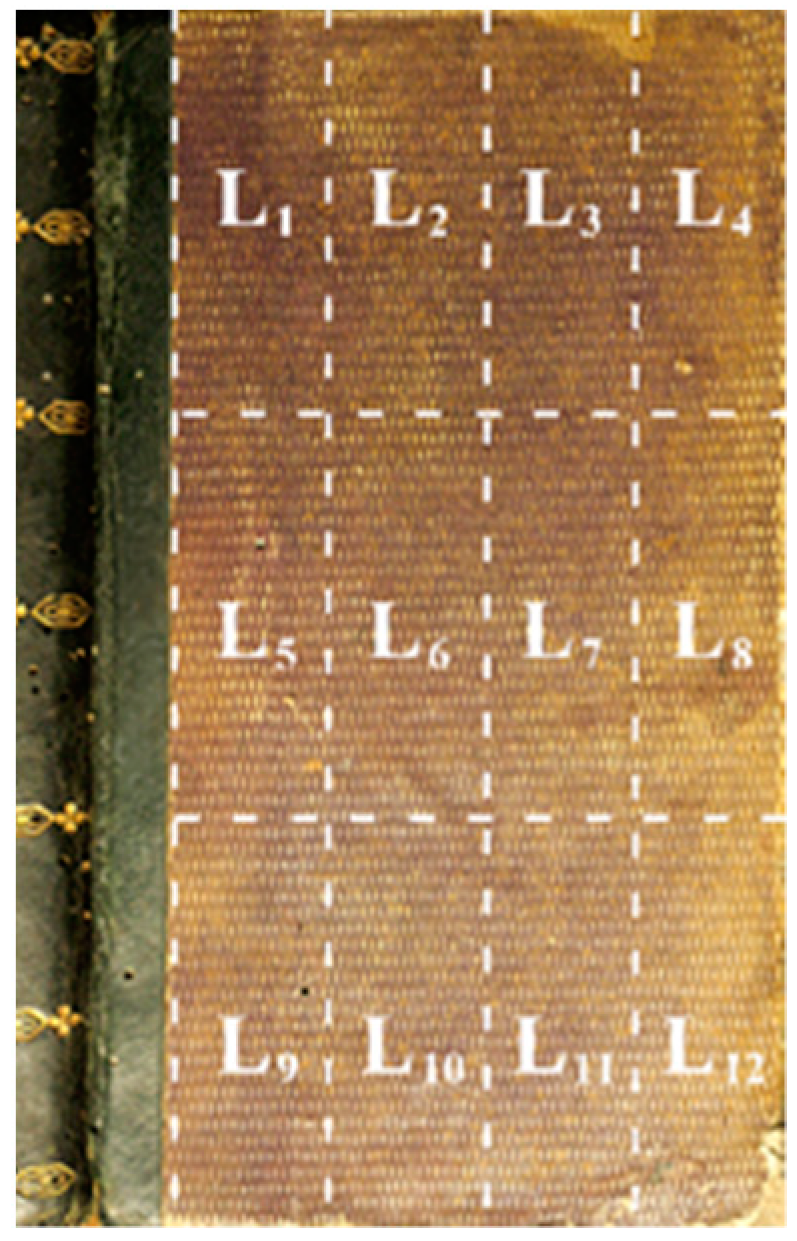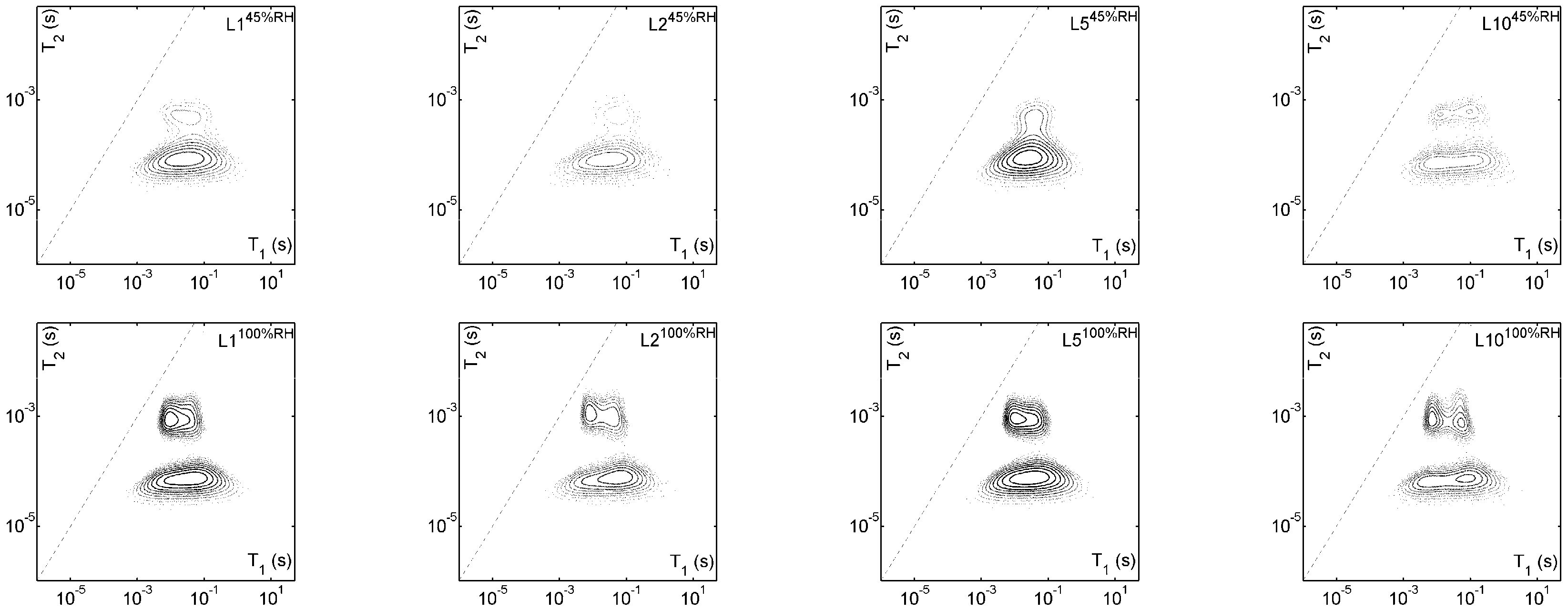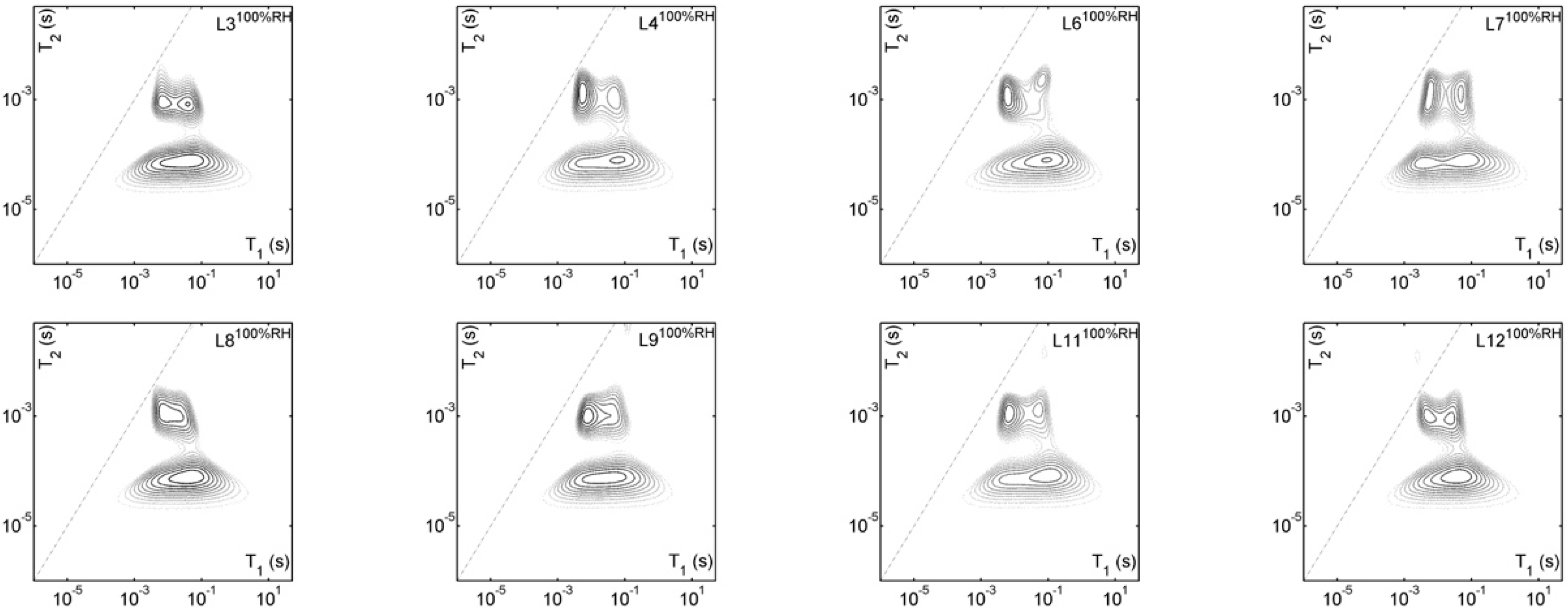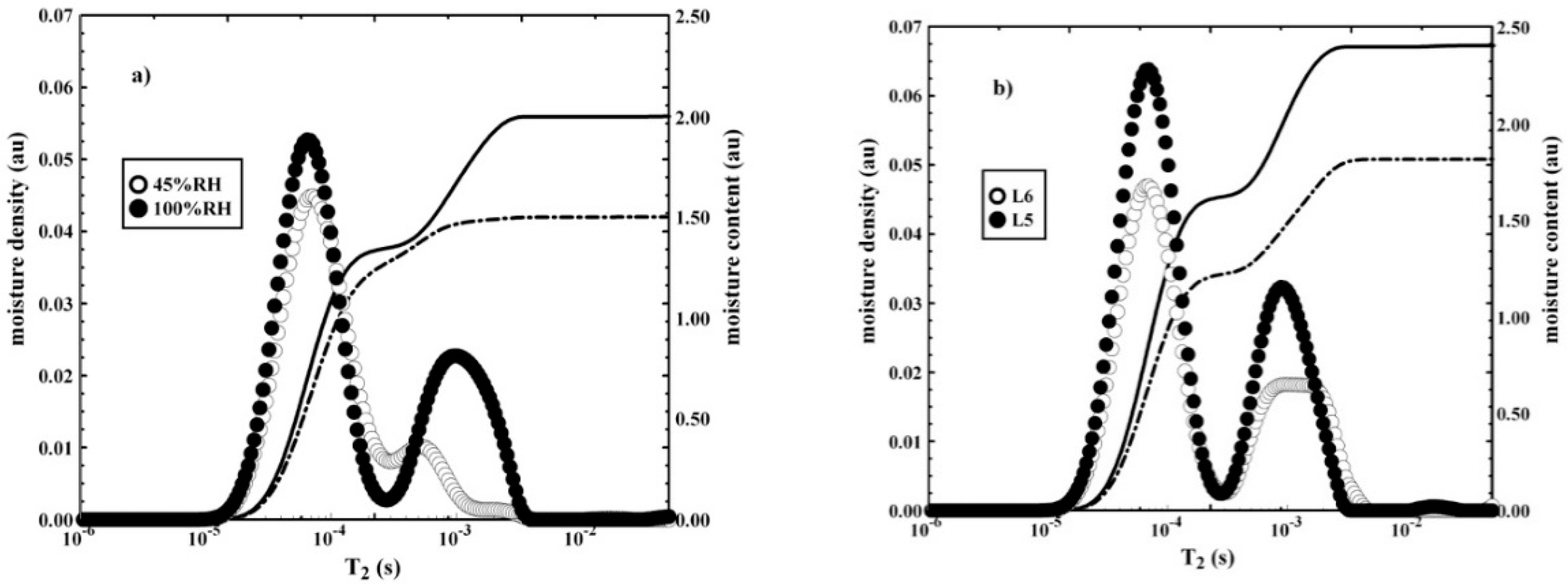NMR Relaxometry and IR Thermography to Study Ancient Cotton Paper Bookbinding
Abstract
:Featured Application
Abstract
1. Introduction
2. Materials and Methods
2.1. 2D 1H-NMR-R
2.2. IRT-HOS
3. Results and Discussion
3.1. 2D 1H-NMR-R Measurements and Processing
3.2. IRT-HOS Measurements and Processing
4. Conclusions
- The 2D 1H NMR-R measurements (Figure 2 and Figure 3) performed on the twelve Ln sections showed the typical T1- and T2-values of water molecules confined in a good quality cellulose paper. In particular, the two-component T2-distribution refers to water molecules trapped among cellulose chains, both as connections set up by one or two molecules (T2-low) or as domains of few molecules, acting like free water (T2-high).
- The influence of increasing the environmental relative humidity from 45% up to 100% on the shape evolution of the T2-distribution (Figure 4), confirms that water molecules, besides being adsorbed on cellulose surfaces, can diffuse into the macromolecular network, swell the structure, and form new hydrogen bonds.
- Contrary to T2′s, the two water domains have a similar T1-value that is quite unrelated to RH. However, for the high-T2′s water molecule domain, we could detect a bimodal T1′s distribution, especially in the 100% RH dataset (Figure 3), apparently caused by paramagnetic impurities in the water clusters.
- For both RH datasets, an evaluation of the moisture content in different areas of the front cover (Table 1) put in evidence the high hydration capacity of L1 and L5 sections compared to others. This behavior seems to be a common aspect for both water phases in the amorphous cellulose network. In our opinion, the larger amount of signal in L1 and L5 could be the effect of biological/chemical degradation phenomena that led to an increase of the amorphous phase. Though crystalline and amorphous domains are always present in cellulose, the crystalline regions are almost unavailable to moisture. Then, the amorphous structure is the sole responsible for the amount of humidity inside the cellulosic network.
- The evaluation of kurtosis value for every pixel in the thermogram matrix provided to get the kurtogram in Figure 5. This displayed a sign of the sub-surface defects and of their thermal diffusivity.
- To explain the spatial inhomogeneity of thermal diffusivity, we took into account not only the presence of air but also of water. In the cellulose-water system, it is reasonable to assume that thermal diffusivity gets higher because of a great water amount.
Supplementary Materials
Author Contributions
Funding
Acknowledgments
Conflicts of Interest
References
- Chapman, P. Guidelines on Preservation and Conservation Policies in the Archives and Libraries Heritage; UNESCO: Paris, France, 1990. [Google Scholar]
- Engel, P. New Approaches to Book and Paper Conservation-Restoration; Verlag Berger: Horn, Austria, 2011. [Google Scholar]
- Song, Y.-Q.; Venkataramanan, L.; Hurlimann, M.D.; Flaum, M.; Frulla, P.; Straley, C. T1–T2 correlation spectra obtained using a fast two-dimensional Laplace inversion. J. Magn. Reson. 2002, 154, 261–268. [Google Scholar] [CrossRef] [PubMed]
- Madruga, F.J.; Ibarra-Castanedo, C.; Conde, O.M.; López-Higuera, J.M.; Maldague, X. Infrared thermography processing based on higher-order statistics. NDT E Int. 2010, 43, 661–666. [Google Scholar] [CrossRef]
- Blümich, B.; Perlo, J.; Casanova, F. Mobile single-sided NMR. Prog. Nucl. Magn. Reson. Spectrosc. 2008, 52, 197–269. [Google Scholar] [CrossRef]
- Maldague, X.P.V. Theory and Practice of Infrared Thermography for Non-Destructive Testing; Wiley: New York, NY, USA, 2001. [Google Scholar]
- Blümich, B.; Anferova, S.; Sharma, S.; Segre, A.L.; Federici, C. Degradation of historical paper: Nondestructive analysis by the NMR-MOUSE. J. Magn. Reson. 2003, 161, 204–209. [Google Scholar] [CrossRef]
- Viola, I.; Bubici, S.; Casieri, C.; De Luca, F. The codex major of the collectio altaempsiana: A non-invasive NMR study of paper. J. Cult. Herit. 2004, 5, 257–261. [Google Scholar] [CrossRef]
- Sfarra, S.; Regi, M.; Tortora, M.; Casieri, C.; Perilli, S.; Paoletti, D. A multi-technique nondestructive approach for characterizing the state of conservation of ancient bookbindings. J. Therm. Anal. Calorim. 2018, 132, 1367–1387. [Google Scholar] [CrossRef]
- Klemm, D.; Philipp, B.; Heinze, T.; Heinze, U.; Wagenknecht, W. Comprehensive Cellulose Chemistry. Volume I: Fundamentals and Analytical Methods, 1st ed.; WILEY-VCH Verlag GmbH: Weinheim, Germany, 1998. [Google Scholar] [CrossRef]
- Hatakeyama, H.; Hatakeyama, T. Interaction between water and hydrophilic polymers. Thermochim. Acta 1998, 308, 3–22. [Google Scholar] [CrossRef]
- Corsaro, C.; Mallamace, D.; Vasi, S.; Pietronero, L.; Mallamace, F.; Missori, M. The role of water in the degradation process of paper using 1H HR-MAS NMR spectroscopy. Phys. Chem. Chem. Phys. 2016, 18, 33335–33343. [Google Scholar] [CrossRef]
- Zhang, C.; Li, P.; Zhang, Y.; Lu, F.; Li, W.; Kang, H.; Xiang, J.; Huang, Y.; Liu, R. Hierarchical porous structures in cellulose: NMR relaxometry approach. Polymers 2016, 98, 237–243. [Google Scholar] [CrossRef]
- Terenzi, C.; Prakobna, K.; Berglund, L.A.; Furó, I. Nanostructural effects on polymer and water dynamics in cellulose biocomposites: 2H and 13C NMR relaxometry. Biomacromolecules 2015, 16, 1506–1515. [Google Scholar] [CrossRef]
- Lindh, E.L.; Terenzi, C.; Salmen, L.; Furó, I. Water in cellulose: Evidence and identification of immobile and mobile adsorbed phases by 2H MAS NMR. Phys. Chem. Chem. Phys. 2017, 19, 4360–4369. [Google Scholar] [CrossRef]
- Brückle, I. Structure and properties of dry and wet paper. In Paper and Water: A Guide for Conservators; Banik, G., Brückle, I., Eds.; Butterworth-Heinemann: Oxford, UK, 2011; pp. 81–114. [Google Scholar]
- Łojewski, T.; Miskowiec, P.; Molenda, M.; Lubanska, A.; Łojewska, J. Artificial versus natural aging of paper. Water role in degradation mechanisms. Appl. Phys. A 2010, 100, 625–633. [Google Scholar] [CrossRef]
- Castro, K.; Princi, E.; Proietti, N.; Manso, M.; Capitani, D.; Vicini, S.; Madariaga, J.M.; De Carvalho, M.L. Assessment of the weathering effects on cellulose based materials through a multianalytical approach. Nucl. Instrum. Methods B 2011, 269, 1401–1410. [Google Scholar] [CrossRef]
- Paci, M.; Federici, C.; Capitani, D.; Perenze, N.; Segre, A.L. NMR study of paper. Carbohydr. Polym. 1995, 26, 289–297. [Google Scholar] [CrossRef]
- Capitani, D.; Segre, A.L.; Attanasio, D.; Blicharska, B.; Focher, B.; Capretti, G. 1H NMR relaxation study of paper as a system of cellulose and water. Tappi J. 1996, 79, 113–122. [Google Scholar]
- Capitani, D.; Proietti, N.; Ziarelli, F.; Segre, A.L. NMR study of water-filled pores in one of the most widely used polymeric material: The paper. Macromolecules 2002, 35, 5536–5543. [Google Scholar] [CrossRef]
- Mallamace, D.; Vasi, S.; Missori, M.; Mallamace, F.; Corsaro, C. NMR investigation of degradation processes of ancient and modern paper at different hydration levels. Front. Phys. 2018, 13, 138202. [Google Scholar] [CrossRef]
- Lepore, A.; Baccaro, S.; Casieri, C.; Cemmi, A.; De Luca, F. Role of water in the aging mechanism of paper. Chem. Phys. Lett. 2012, 531, 206–209. [Google Scholar] [CrossRef]
- Conti, A.; Poggi, G.; Baglioni, P.; De Luca, F. On the macromolecular cellulosic network of paper: Changes induced by acid hydrolysis studied by NMR diffusometry and relaxometry. Phys. Chem. Chem. Phys. 2014, 16, 8409–8417. [Google Scholar] [CrossRef]
- Casieri, C.; Senni, L.; Romagnoli, M.; Santamaria, U.; De Luca, F. Determination of moisture fraction in wood by mobile NMR device. J. Magn. Reson. 2004, 171, 364–372. [Google Scholar] [CrossRef]
- Mercuri, F.; Zammit, U.; Orazi, N.; Paoloni, S.; Marinelli, M.; Scudieri, F. Active infrared thermography applied to the investigation of art and historic artefacts. J. Them. Anal. Calorim. 2011, 104, 475–485. [Google Scholar] [CrossRef]
- Yamauchi, T.; Okumura, S.; Noguchi, M. Application of thermography to the deforming process of paper materials. J. Mater. Sci. 1993, 28, 4549–4552. [Google Scholar] [CrossRef]
- Maldague, X.; Krapez, J.C.; Poussart, D. Thermographic nondestructive evaluation (NDE): An algorithm for automatic for automatic defect extraction in infrared images. IEEE Trans. Syst. Man Cybern. 1990, 20, 722–725. [Google Scholar] [CrossRef]
- Terenzi, C.; Casieri, C.; De Luca, F.; Quaresima, R.; Quarta, G. Firing-induced microstructural properties of quasi-diamagnetic carbonate-based porous ceramics: A 1H NMR relaxation correlation study. Appl. Magn. Reson. 2015, 46, 1159–1178. [Google Scholar] [CrossRef]
- Klein, M.; Ibarra-Castanedo, C.; Maldague, X.P.; Bendada, A. A straightforward graphical user interface for basic and advanced signal processing of thermographic infrared sequences. In Thermosense XXX, Proceedings of the SPIE Defense and Security Symposium, Orlando, FL, USA, 16–20 March 2008; Vavilov, V.P., Burleigh, D.D., Eds.; SPIE: Bellingham, WA, USA, 2008. [Google Scholar] [CrossRef]
- Darlington, R.B. Is kurtosis really “peakedness”? Am. Stat. 1970, 24, 19–22. [Google Scholar] [CrossRef]
- Madruga, F.; Ibarra-Castanedo, C.; Conde, O.M.; Maldague, X.P.; López-Higuera, J.M. Enhanced contrast detection of subsurface defects by pulsed infrared thermography based on the fourth order statistic moment, kurtosis. In Thermosense XXXI; Burleigh, D.D., Dinwiddie, R.B., Eds.; E-print: Baltimore, MD, USA, 2009. [Google Scholar] [CrossRef]
- Attanasio, D.; Capitani, D.; Federici, C.; Segre, A.L. Electron spin resonance study of paper samples dating from the fifteenth to the eighteenth century. Archaeometry 1995, 37, 377–384. [Google Scholar] [CrossRef]
- Casieri, C.; Bubici, S.; Viola, I.; De Luca, F. A low-resolution non-invasive NMR characterization of ancient paper. Solid State Nucl. Magn. 2004, 26, 65–73. [Google Scholar] [CrossRef]
- Sheng, C.K.; Mat Yunus, W.M. Thermal diffusivity measurement of the commercial papers using photoacoustic technique. Pertanika J. Sci. Technol. 2002, 10, 161–166. [Google Scholar]
- Morikawa, J.; Hashimoto, T. Thermal diffusivity measurement of papers by an AC Joule heating method. Polym. Int. 1999, 45, 207–210. [Google Scholar] [CrossRef]





| 45% RH | 100% RH | |||||||
|---|---|---|---|---|---|---|---|---|
| MClow | MChigh | MCtot | %MChigh | MClow | MChigh | MCtot | %MChigh | |
| L1 | 1.29 | 0.32 | 1.61 | 0.20 | 1.47 | 0.74 | 2.22 | 0.34 |
| L2 | 1.05 | 0.25 | 1.31 | 0.19 | 1.22 | 0.59 | 1.81 | 0.33 |
| L3 | 1.17 | 0.29 | 1.46 | 0.20 | 1.33 | 0.62 | 1.96 | 0.32 |
| L4 | 1.29 | 0.24 | 1.53 | 0.15 | 1.20 | 0.65 | 1.85 | 0.35 |
| L5 | 1.52 | 0.34 | 1.86 | 0.18 | 1.62 | 0.78 | 2.40 | 0.32 |
| L6 | 1.08 | 0.28 | 1.36 | 0.20 | 1.22 | 0.59 | 1.82 | 0.33 |
| L7 | 1.28 | 0.29 | 1.58 | 0.18 | 1.23 | 0.64 | 1.86 | 0.34 |
| L8 | 1.26 | 0.23 | 1.50 | 0.16 | 1.35 | 0.65 | 2.00 | 0.33 |
| L9 | 1.11 | 0.34 | 1.46 | 0.23 | 1.23 | 0.69 | 1.92 | 0.36 |
| L10 | 0.99 | 0.32 | 1.31 | 0.24 | 1.17 | 0.58 | 1.75 | 0.33 |
| L11 | 1.24 | 0.29 | 1.53 | 0.19 | 1.21 | 0.58 | 1.78 | 0.32 |
| L12 | 1.28 | 0.30 | 1.59 | 0.19 | 1.19 | 0.59 | 1.78 | 0.33 |
| m ±σ | 1.21 ± 0.14 | 0.29 ± 0.04 | 1.51 ± 0.15 | 0.19 ± 0.03 | 1.29 ± 0.14 | 0.64 ± 0.07 | 1.93 ± 0.20 | 0.33 ± 0.01 |
© 2019 by the authors. Licensee MDPI, Basel, Switzerland. This article is an open access article distributed under the terms and conditions of the Creative Commons Attribution (CC BY) license (http://creativecommons.org/licenses/by/4.0/).
Share and Cite
Tortora, M.; Sfarra, S.; Casieri, C. NMR Relaxometry and IR Thermography to Study Ancient Cotton Paper Bookbinding. Appl. Sci. 2019, 9, 3406. https://doi.org/10.3390/app9163406
Tortora M, Sfarra S, Casieri C. NMR Relaxometry and IR Thermography to Study Ancient Cotton Paper Bookbinding. Applied Sciences. 2019; 9(16):3406. https://doi.org/10.3390/app9163406
Chicago/Turabian StyleTortora, Mariagrazia, Stefano Sfarra, and Cinzia Casieri. 2019. "NMR Relaxometry and IR Thermography to Study Ancient Cotton Paper Bookbinding" Applied Sciences 9, no. 16: 3406. https://doi.org/10.3390/app9163406






